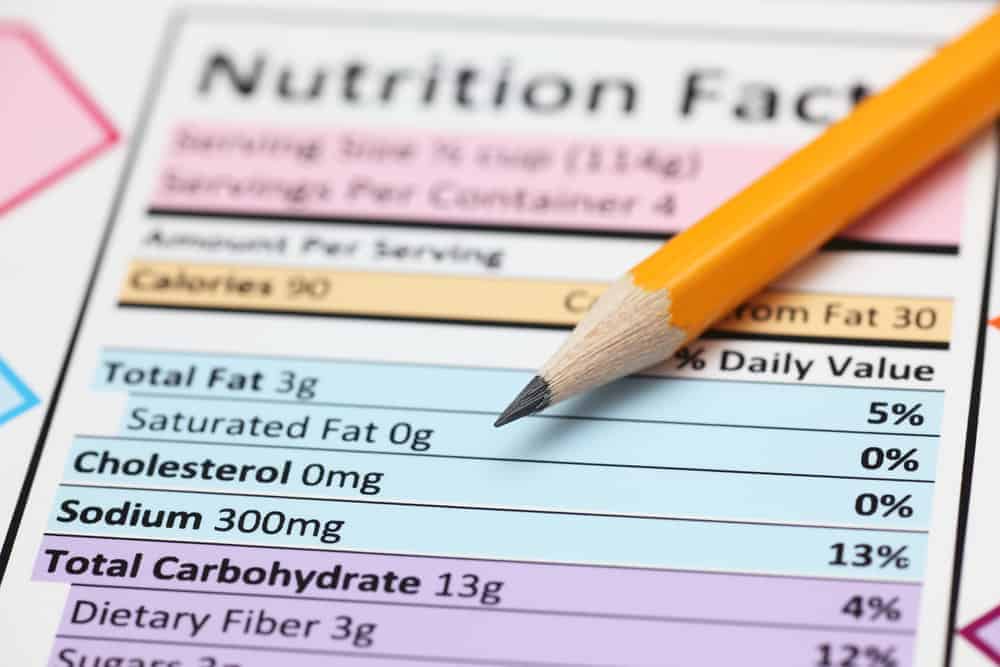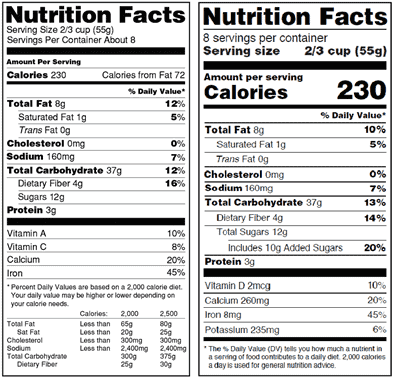Blog
Drastic Changes Coming to Nutrition Facts Panel
The US Food and Drug Administration (FDA) has published new changes, on 20th May 2016, to the Nutrition Facts panel that appears on all packaged food products.
The changes were intended to be implemented by 26th July 2018, but the FDA has extended the deadline date to the 1st January 2020 for those manufacturers that have annual food sales of $10 million or more and to 1st January 2021 for those manufacturers with sales of less than $10 million.
While the dates may have been moved, it is still worthwhile to look at the changes that are to be implemented and what they will mean for you, the consumer.
The bottom line of the changes is that the FDA hopes the new label will make it easier for the consumer to link diet with chronic diseases and obesity and to take advantage of the latest in scientific research.
Let’s look at the main areas of change. In the picture below, the old label is on the left and the new on the right.
New Nutritional Facts Panel.
(Courtesy of https://www.fda.gov/Food/GuidanceRegulation/GuidanceDocumentsRegulatoryInformation/LabelingNutrition/ucm385663.htm)
New, more modern design
The existing “look” of the panel will remain the same. The significant changes are around the size of some lettering to highlight specific pertinent facts so that these facts are brought to the attention of the consumer. For example, the words ‘Serving Size’, ‘Calories’ and ‘Servings per Container’ are now in a larger font and the number of calories and the serving size must be in bold print, so they catch the eye of the consumer.
Changes to the declaration for certain minerals and vitamins
In future not only will Calcium and Iron will be required to be listed, but Potassium has also been added to the list of necessary minerals. Vitamins A and C may be voluntarily declared, but Vitamin D is compulsory.
No longer is it sufficient for manufacturers to declare the percent Daily Value for the minerals iron and potassium and for Vitamin D. Now they must also include the actual number of milligrams of each of these minerals and vitamins.
The declaration for other vitamins is voluntary.
Change to the footnote
The footnote will be changed to make it easier for the consumer to understand what the Daily Value means. The Daily Diet is based on a general nutritional value of 2,000 calories per day, and the % Daily Value (DV) is a percentage of how much each item on the label contributes toward that generalized daily diet of 2,000 calories.
For example, in the label above 260mg Calcium in this product will provide 20% of the total calcium that a human should eat per day should they be on a diet of 2,000 calories per day and they adhere to the 55g serving size for this product.
Added Sugar
The label will now include the number of grams and a daily value percent for added sugar. This is being done to bring the label in line with the 2015-2020 Dietary Guidelines for Americans, where it is stated that if your intake of sugars is greater than 10% of your total calories per day, it is impossible to take in sufficient nutrients and adhere to your calorific limits.
Sugar is an integral part of any healthy diet, but research shows that the average American gets about 13% of their total daily calories from sugar. The primary culprits for this intake are beverages sweetened with sugar, sweets, snacks, and sweet toppings on many products. To try and manage this intake of sugar, the new labels will allow you to start keeping tabs on where you are eating sugars that may not be immediately apparent from the product itself.
Fats
The label will continue to require the information and breakdown of fats, including trans-fats, but the calories from fats have been removed. The latest in scientific research shows that the type of fat is more important than the number of calories from fat.
Daily Values for Nutrients
The FDA has published updated guidelines for the daily values for specific nutrients such as dietary fiber, sodium and vitamin D. This is done based on research and the latest scientific information from the Institute of Medicine as well as the report from the advisory committee for the 2015-2020 Dietary Guidelines for Americans.
These Daily Values give the amount of a specific nutritional element that should be consumed every day.
Serving Sizes
Legally, the serving size must be based on what people are actually eating and not what they should be eating. The current serving size was calculated in 1933, and the serving size since then has changed substantially.
An excellent example of this is for ice cream, where the 1933 serving size was ½ cup but the latest research shows that it is actually ⅔ cup today while carbonated drinks (sodas) used to be 8 ounces and now it is 12 ounces.
Package Sizes vs. Serving Sizes
It is a very well-known fact that a package size has a significant effect on what people eat. Manufacturers that package items in such a way that they fall in-between a number of serving and indirectly encouraging people to eat more than they should.
For example, a can of soup that weighs 15 ounces, falls right in the middle of one and two servings, and will, in future, have to be labeled as one serving with the nutritional facts aligned to one serving because that is the way that the reasonable person would consume that can of soup.
Packages larger than one serving
If a package is larger than one individual serving, such as a pint of ice cream, manufacturers will have to provide an extra column on the Nutritional Facts Panel. These ‘dual column’ labels will have to give all the nutritional information for one serving along with the nutritional and calorie information for the entire package.
In this way consumers will be able to understand the total number of calories and other dietary elements that they will consume should they eat the whole package at one time.
As the current label was designed over 20 years ago, it is a good idea to bring it up to date with all the latest in scientific thinking. It is important to note that these changes will also apply to any food imported into the USA from other countries.






